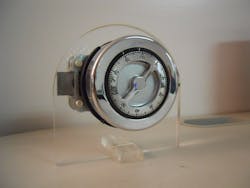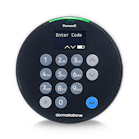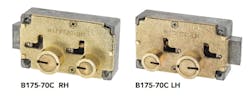Since 2008, the number of residences having safes has increased significantly. Commercial safe sales have also increased. Many of the new safes sold are equipped with an electronic safe lock. Just about every safe manufacturer either offers the electronic safe lock as an option or on some models as standard equipment.
Electronic safe locks are convenient and the safe can be opened faster than when dialing a mechanical safe lock. The idea behind the electronic safe lock was to simplify dialing the combination to eliminate user errors. Electronic safe locks eliminate having to remember how many turns for each number and which direction to rotate the dial.
The electronic safe lock has become very popular. However, with the good usually comes the not so good. Though more difficult to operate, mechanical safe locks have a nominal failure rate. Electronic safe locks contain electronics, which are prone to failure at some point in time. Safe lock failure is very different from just about any other type of lock failure.
Enter the new NL Lock Duet Safe Lock, the DL20-20 Electronic Lock with Mechanical Override. This model is designed for two user codes. This straight bolt, redundant safe lock contains both a mechanical three-wheel lock and an electronic lock built into one lock case. The NL Lock Duet is a Group 1 Electronic and Mechanical Group 2M rated lock offering the convenience of an electronic lock with the nominal failure rate of a mechanical lock. Unlike other redundant safe locks that have both a separate dial and digital keypad, the Duet has a digital keypad built into the dial.
If one mechanism fails to operate, the safe can be opened using the other, eliminating the possibly to have to drill and repair the container.
Duet combination lock electronic components include a motor-driven release mechanism. When the six-digit combination is entered into the keypad, the motor rotates only one-quarter revolution, removing the blocking mechanism. This permits the lever to slide into the fence. The unlocking timeframe is four seconds to rotate the dial clockwise until the bolt is retracted. After the four-second unlock period, the spring-loaded fence blocker arm releases. In this position, the bolt can only be extended. As the bolt extends, the blocker returns to the neutral position.
To operate the lock electronically, the Duet has a keypad across the top of the housing. Two rows of numbers have a red LED positioned between numbers 1 and 2 and 6 and 7. The LED illuminates and the piezo sounds each time a number is pressed. When the correct "master" code (combination) has been entered, the LED will illuminate twice and piezo sounds twice. Within four seconds, rotate the dial clockwise until the bolt retracts and the dial stops. If an incorrect code has been entered, the LED illuminates and the piezo sounds for approximately two seconds.
To operate the Duet lock mechanically, rotate the dial to position the three wheels in order to retract the bolt. Begin by rotating counterclockwise (left) to the first number and then three more rotations, positioning that number directly beneath the opening index. Rotate the dial clockwise (right) passing over the number and continuing to rotate two more rotations, positioning that number directly beneath the opening index. Rotate counterclockwise (left) to the third number and then one more rotation, positioning that number directly beneath the opening index. The final rotation is clockwise when the lever slides into the fence and retracts the bolt to the unlocked position. The dial stops beneath the opening index between 90 and 95.
Important: When changing the combination, always have the door open.
Electronic Combination Change
Enter the existing code. The lock will beep and illuminated twice to confirm the correct code. Open the safe door.
With the safe door open, press and hold the “0” button until a double signal is emitted. The LED will illuminate and stay lit during the programming procedure.
Enter the existing "master" code. A double signal is emitted.
Enter the new "master" code. A double signal is emitted.
Enter the new "master" code a second time. A double signal is emitted.
If the "master" code was entered properly, the LED will extinguish.
Test the new "master" code. When the code has been entered, the LED will flash twice and a double signal will be emitted. Rotate the dial clockwise until the bolt retracts. If the lock will not unlock, the code change was not correct. If the code change was not correct, the old "master" code remains valid.
To add the second user code, press and hold the “1” button until a double signal is emitted and the LED stays illuminated.
Enter correct "master" code. A double signal is emitted.
Enter new second code. A double signal is emitted and the LED stays illuminated.
Enter new second code a second time. A double signal is emitted and the LED will extinguish.
Test the new second user code. When the code has been entered, the LED will flash twice and a double signal will be emitted. Rotate the dial clockwise until the bolt retracts.
Mechanical Combination Change
To change the mechanical combination, dial the combination, retract the bolt and open the door.
With the door open, dial the combination stopping at the changing index, not the opening index.
A hole in the cover of the safe lock at approximately 7 o’clock is where the change key is inserted and the combination changed. To change the Duet mechanical lock combination, use the change key part number T005.
Important: The combination must be dialed correctly for the change key to slide into place. Never force the change key into the opening.
When the change key is properly seated, rotate the handle clockwise until it stops. The wheels will be released, permitting the combination to be changed.
Dial a new combination to the changing index. Follow the same steps as when dialing the combination in order to open the safe. The only difference is to the changing index, not the opening index. Make sure the combination is properly dialed. If one of the numbers is off when dialed, the combination will reflect the new number.
The Duet lock body has the same bolt pattern and height and width dimensions as a standard combination lock. The thickness of the Duet lock is 1-1/2”, approximately 3/8” thicker than a standard lock body. The additional space contains the electronic components.
The straight-bolt Duet safe lock can be mounted in the four mounting directions. When retrofitting the Duet into a boltwork equipped safe, make sure there is approximately 1/16” clearance between the lock bolt and the cutout in the blocking bar of the boltwork.
The Duet Electronic Safe Lock is assembled in the United States.
The Duet Safe Lock is powered by a 9Volt alkaline battery. Battery life is rated at 3,000 openings. When the battery loses a sufficient amount of power, the lock will signal a low warning. Slide the battery door at the bottom of the lock counterclockwise and remove the old battery from the bottom. NL Lock recommends using Duracell or Energizer batteries.
Future models will have additional software features.
For more information, contact Nick Gartner at [email protected]






